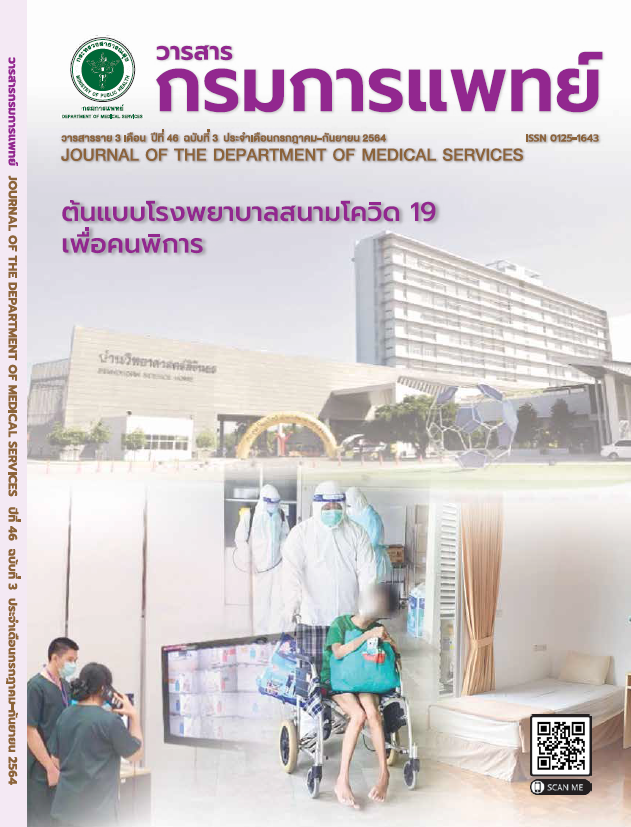The Survival Rate of Thai Dental Implants (Fun Yim) Retained Overdenture of the Royal Dental Implant Project in Elderly Patients at Neurological Institute of Thailand
Keywords:
Thai dental implant, Dental implants retained overdenture, The Royal dental implant project, Fun YimAbstract
Background: Because of the Royal dental implant was the first Thai dental implant project that was developed and produced by Thai people.Objective: This study was to evaluate the survival rate of Thai dental implants (Fun Yim) retained overdenture of the Royal dental implant project in elderly patients which had been installed and restored at Neurological Institute of Thailand since 2009 to 2012 (8-11 years results).Method: The data of 468 functioning dental implants from 234 subjects were collected. Clinical parameters were recorded including, bleeding index, gingival index, probing pocket depth, mobility and bone loss from x-ray flim.Result: They showed the median of bleeding index was 0.00 and Interquartile range (IQR) was 0.00-1.00, the median of gingival index was 0.00 and Interquartile range (IQR) was 0.00-1.00, the median of probing pocket depth was1.00 and Interquartile range (IQR) was 1.00-2.00, mobility was 2.8% , no bone loss was 53%, level boneloss ≤ 25% was 36.8%, boneloss 25%-50% was 8.5% and boneloss ≥ 50% was 1.7%. The survival rate of implant was 94.6%.Conclusion: The survival rate of Thai dental implants (Fun Yim) retained overdenture of the Royal dental implant project in elderly patients at Neurological Institute of Thailand was 94.6%.
References
Assad AS, Abd El-Dayem MA, Badawy MM. Comparison between mainly mucosa-supported and combined mucosa-implantsupported mandibular overdentures. Implant Dent 2004;13:386-94.
Chan MF, Johnston C, Howell RA, Cawood JI. Prosthetic management of the atrophic mandible using endosseous implants and overdentures: a six year review. Br Dent J 1995;179:329-37.
Naert I, Alsaadi G, Quirynen M. Prosthetic aspects and patient satisfaction with two-implant-retained mandibular overdentures:a 10-year randomized clinical study. Int J Prosthodont 2004;17:401-10.
Tallgren A. The continuing reduction of the residual alveolar ridges in complete denture wearers: a mixed-longitudinal study covering 25 years. J Prosthet Dent 1972; 27:120-32.
Sadowsky SJ. The implant-supported prosthesis for the edentulous arch: design considerations. J Prosthet Dent 1997;78:28-33.
Cordioli G, Majzoub Z, Castagna S. Mandibular overdentures anchored to single implants: a five-year prospective study. J Prosthet Dent 1997; 78:159-65.
Gotfredsen K, Holm B. Implant-supported mandibular overdentures retained with ball or bar attachments: a randomized prospective 5-year study. Int J Prosthodont 2000;13:125-30.
Albrektsson T, Isidor F. Consensus report of session IV. In: Lang NP, Kerring T, eds. Proceeding of the first European workshop on periodontology. Germany: Quintessence Publishing; 1994.
Ten Bruggenkate CM, van der Kwast WA, Oosterbeek HS. Success criteria in oral implantology. A review of the literature. Int J Oral Implantol 1990; 7:45-51.
Misch CE, Perel ML, Wang HL, Sammartino G, Galindo-Moreno P, Trisi P, et al. Implant success, survival, and failure: the International Congress of Oral Implantologists (ICOI) Pisa Consensus Conference. Implant Dent 2008;17:5-15.
Lang NP, Berglundh T, Heitz-Mayfield LJ, Pjetursson BE, Salvi GE, Sanz M. Consensus statement and recommended clinical procedures regarding implant survival and complications. Int J Oral Max Impl 2004;19:150-54.
Mombelli A, van Oosten MA, Schurch E Jr, Land NP. The microbiota associated with successful or failing osseointegrated titanium implants. Oral Microbiol Immunol 1987;2:145-51.
Loe H. The gingival index, the plaque index and the retention index system. J Periodontol 1967;38: 610-6.
Moraschini V, Poubel LA, Ferreira VF, Barboza Edos S. Evaluation of survival and success rates of dental implants reported in longitudinal studies with a follow-up period of at least 10 years:a systematic review. Int J Oral Maxillofac Surg 2015;44:377-88.
Berglundh T, Persson L, Klinge B. A systematic review of the incidence of biological and technical complications in implant dentistry reported in prospective longitudinal studies of at least 5 years. J Clin Periodontol 2002;29:197-212.
Roos-Jansaker AM, Lindahl C, Renvert H, Renvert S. Nine-to fourteen-year follow-up of implant treatment. Part I: implant loss and associations to various factors. J Clin Periodontol 2006;33:283-9.
Roos-Jansaker AM, Lindahl C, Renvert H, Renvert S. Nine-to fourteen-year follow-up of implant treatment. Part II: presence of peri-implant lesions. J Clin Periodontol 2006;33:290-5.
Roos-Jansaker AM, Renvert H, Lindahl C, Renvert S. Nine-to fourteen-year follow-up of implant treatment. Part III: factors associated with peri-implant lesions. J Clin Periodontol 2006;33:296-301.
Roccuzzo M, De Angelis N, Bonino L, Aglietta M. Ten-year results of a three-arm prospective cohort study on implants in periodontally compromised patients. Part 1: implant loss and radiographic bone loss. Clin Oral Implants Res 2010; 21:490-6.
Humphrey S. Implant maintenance. Dent Clin N Am 2006;50:463-78.
Palmer RM, Pleasance C. Maintenance of osseointegrated implant prostheses. Dent Update 2006;33:84-92.
Duyck J, Naert I. Failure of oral implants: aetiology, symptoms and influencing factors. Clin Oral Investig 1998;2:102-14.
Goodacre CJ, Bernal G, Rungcharasseng K, Kan JY. Clinical complications with implants and implant prostheses. J Prosthet Dent 2003; 90:121-32.
Downloads
Published
How to Cite
Issue
Section
License

This work is licensed under a Creative Commons Attribution-NonCommercial-NoDerivatives 4.0 International License.
บทความที่ได้รับการตีพิมพ์เป็นลิขสิทธิ์ของกรมการแพทย์ กระทรวงสาธารณสุข
ข้อความและข้อคิดเห็นต่างๆ เป็นของผู้เขียนบทความ ไม่ใช่ความเห็นของกองบรรณาธิการหรือของวารสารกรมการแพทย์



